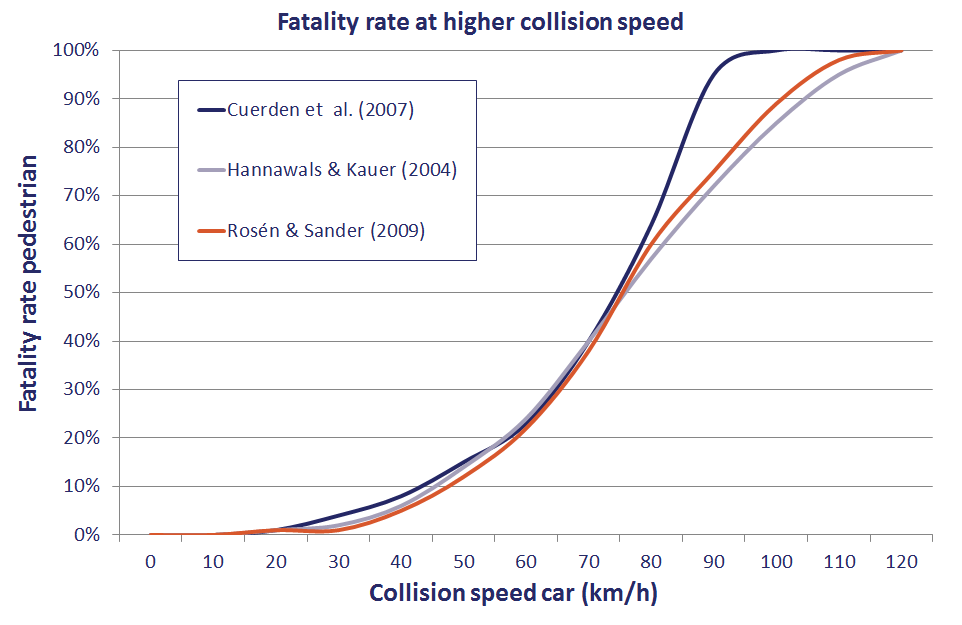Car Crash Survival Rate Speed
If either car in an accident is traveling faster than 43 mph the chances of surviving a head-on crash plummet. A fatal car accident is practically inevitable at speeds of 70 mph or more.

Driving Too Fast Nsw Centre For Road Safety
About 90 survive at a collision speed of 40 kmh at a collision speed of 80 kmh the number of survivors is less than 50 and at a collision speed of 100 kmh only 10 of the pedestrians survive.

. New AAA and IIHS crash tests reveal that modest speed increases can have deadly consequencesSmall speed increases can have huge effects on crash ou. This figure shows that the risk of car driver fatality in an impact with a delta-v of 30 mph is approximately 3 at 40 mph the risk is approximately 17 and at 50 mph the risk is approximately 60. Bill Lindeke June 23 2016.
Dont crash your car into a wall if. Most newer models earn top marks for frontal crashworthiness in the federal governments 35 mph test head-on into a rigid barrier and the IIHS 40 mph moderate overlap test into a deformable barrier. Risks vary significantly by age.
70 MPH is the average speed limit on most US highways. Collisions between cars also have dire consequences as the speed increases. A series of crash tests by IIHS and partners shows that impact speeds of 50 mph or 56 mph are far more likely to lead to injury or death than 40 mph impacts.
Pedestrian Crash Survival Rates by Age and Speed of Car. Read on to learn what you can do before during and after a car accident that can help you and your passengers survive a crash. Figure 33 shows the risk of car driver fatality in frontal impacts by the delta-v of the impact.
Many but not all late-model vehicles earn acceptable or good ratings from IIHS for protection in a small overlap front crash. Looking at the above graph you would be over 28 gs for about 004 seconds. In 2019 the death rate was 141 per 10000 vehicles a 96 improvement.
It is also the speed at which a fatal car accident becomes practically inevitable. At 80 that number becomes drastically lower. Once cars reach a certain speed just above 20 mph they rapidly become more deadly.
What you do in those few seconds can make a difference in the severity of the accident and may even save your life. 93 percent of all people hit would survive a. In collisions at 30 miles per hour about one in five pedestrians will not survive.
Answer 1 of 8. Such a crash carries as low as a 25 percent chance of survival. One study shows that doubling the speed from 40 to 80 actually quadruples the force of impact.
In 1923 the first year miles driven was estimated the motor-vehicle death rate was 1865 deaths for every 100 million miles driven. Simply put pedestrian safety is basic physics. Motor vehicle crashes are the most common cause of unintentional life lost around the.
When a car is going slowly the risk of serious injury is about 1. According to AAAs Brian Teffts data a person is about 70 percent more likely to be killed if theyre struck by a vehicle traveling at 30 mph versus 25 mph. The fundamental relationship here is really not that complicated and there have been lots of charts showing the correlation between speed and fatality in crashes.
I personally was just in one Monday going 85 my car spun out and I went straight into a wall. In my observations from studying crashes once you get up to around 300 of the forces your vehicle was designed to handle your odds of survival drop down to around 25. I instantly hopped out the car and looked at the damage I probably didnt feel anything becau.
I actually didnt even have airbags because the car had already slid into a ditch before. When you look at how low the fatality rate is at that speed its easy to see why this is such a good idea. A 70 mph crash carries more than 2x as energy or precisely 306 as much energy as the 40 mph crash 100 of tested forces.
For example the average risk of severe injury or death for a 70year old pedestrian struck by a car traveling at 25 mph is similar to the risk for a 30yearold pedestrian struck at 35 mph. Chart of the Day. To put it another way in a head-on crash at 70 mph involving 2.
Even at 70 mph your chances of surviving a head-on collision drop to 25 percent. Since 1923 the mileage death rate has decreased 93 and now stands at 120 deaths per 100 million miles driven. At 50 mph the risk increases to 69 for injury and the risk for serious injury increases to 52.
The average risk of death for a pedestrian reaches 10 at an impact speed of 23 mph 25 at 32 mph 50 at 42 mph 75 at 50 mph and 90 at 58 mph. This is bad. At that point youre shifting from crash avoidance to crash survival.
Car crash survival rates increase with being younger male and driving a big vehicle. Factsheet The relation between speed and crashes Author.

The Physics Of A High Speed Crash 70 Mph Vs 85 Mph Wired

Pedestrians What Is The Correlation Between Collision Speed Of Cars And Pedestrian Fatality Rate Swov

How Fast Do You Have To Hit A Stationary Car To Die Or Be Seriously Injured Quora

Wramborg S Model For Fatality Probability Vs Vehicle Collision Speeds Download Scientific Diagram

Speed And Fatalities Pedestrians Staying Safe Nsw Centre For Road Safety
Why Speed Matters Streets For The People

Wramborg S Model For Fatality Probability Vs Vehicle Collision Speeds Download Scientific Diagram

No comments for "Car Crash Survival Rate Speed"
Post a Comment